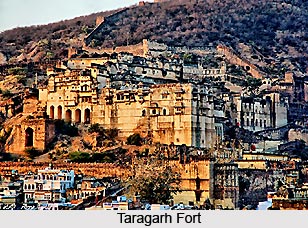 The monuments of Bundi are well known for their Rajput architecture. Most of these edifices are either palaces or forts. For instance the Taragarh Fort is one of the prime attractions for the tourists. As far as Bundi is concerned, this delightful town is completely unspoilt, being situated well off the usual tourist route. It is the chief town of the old state of Bundi. To the north lie the former states of Jaipur and Tonk, to the cast and south, Kota, and to the west, Udaipur. The history of Bundi state is that of its ruling family, the Hara Chauhan clan of Rajputs, who were held in high esteem in the princely hierarchy.
The monuments of Bundi are well known for their Rajput architecture. Most of these edifices are either palaces or forts. For instance the Taragarh Fort is one of the prime attractions for the tourists. As far as Bundi is concerned, this delightful town is completely unspoilt, being situated well off the usual tourist route. It is the chief town of the old state of Bundi. To the north lie the former states of Jaipur and Tonk, to the cast and south, Kota, and to the west, Udaipur. The history of Bundi state is that of its ruling family, the Hara Chauhan clan of Rajputs, who were held in high esteem in the princely hierarchy.
The town lies on the side of a steep hill. The palace dominates the foreground, with its pinnacled terraces and pavilions rising one above the other. Taragarh Fort is located in Bundi in Rajasthan. Also known as the Star Fort, it was built in 1342. As far as its architecture is concerned, Taragarh Fort is square in plan with large corner bastions. In the middle of the west wall is a fine gateway and in the middle of the east wall, a postern. The ramparts are crenellated, with high parapets. The main gate to the west is flanked by octagonal towers defended by a strong barbican. The approach is difficult, always commanded by the towers above. The main entrance has vaulted guardrooms. The fort is dominated by a huge masonry tower, the Bhim Burj, which provided a gun platform for cannon. The Sabirna-Dha-Ka-Kund is a square, stepped water tank with great depth. Built in 1654, it is a marvellous exercise in three-dimensional geometry.
With increasing security the Hara Rajputs constructed outside the Taragarh Fort as well. The City Palace was begun in 1580 by Balwant Singh. It is a distinguished piece of Rajput architecture, running from the women`s quarters half-way up the hill. The Chatar Mahal palace was built in 1660 by Chatar Sal, a loyal servant of Emperor Shah Jahan. It is the largest and most impressive of the jumble of palaces that cascade down the hillside. Built in a green serpentine rock, it is an exercise in Rajput architecture unadulterated by Mughal influences. Characteristic motifs such as lotus-flower spandrels and elephant symbols recur throughout, amid a profusion of arcuated roofs, kiosks and pavilions. A steep carriageway provides access. The first gate is Hazari Pol or Gate of the Thousand, where the garrison lived. The palace quarters are entered via the Hathi Pol (1607-1631), an enormous stone gateway spanned by ornamental elephants and decorated in red, yellow, blue, white and silver. Within the porch is an old water clock, supervised by an elderly retainer. In the Diwan-i-Am or Hall of Public Audience there is a canopied balcony where the ruler made his appearance.
The Chitra Mahal, an open courtyard with a gallery running around a garden of fountains, has a fine collection of Rajput miniatures in the local Bundi style depicting scenes from Raslila, the Radha-Krishna story. The colour scheme in blue, green, white and turquoise is exquisite. The murals on the walls of the cloister of the Chitra Shall {mid-18th century) are some of the finest in Rajput art. It is alleged that the area beneath the fort and palace is honeycombed with subterranean passages leading to the Chatar Mahal. Deep in these underground caverns the state treasure is supposed to be stored. Each ruler was permitted a single visit, but when the last surviving guide died in the 1940s, the secret of its precise location was lost, a tantalizing enigma buried in the haunted ruins of Bundi`s past.
Sukh Niwas is a summer palace on the Jait Sagar tank with a beautiful formal garden, the scene of festival processions. The square, artificial lake of Nawal Sagar is visible from the fort, in the centre of which is a half-submerged temple to the Anjan god of water, Varuna. The surface of the lake reflects the entire city and palace, providing a further dimension to its attractions.
To the west of the Nawal Sagar Lake is the Phool Sagar or Flower Palace, a relatively modern complex commenced by Maharaja Bahadur Singh in 1945 AD around a large artificial lake. It is still unfinished. The cenotaphs of the ruling family are at Khshar Bagh.



















